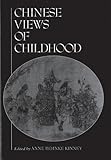Chinese Views of Childhood / ed. by Anne B. Kenney.
Material type: TextPublisher: Honolulu : University of Hawaii Press, [1995]Copyright date: ©1995Description: 1 online resource (368 p.)Content type:
TextPublisher: Honolulu : University of Hawaii Press, [1995]Copyright date: ©1995Description: 1 online resource (368 p.)Content type: - 9780824861889
- 305.23/0951
- online - DeGruyter
| Item type | Current library | Call number | URL | Status | Notes | Barcode | |
|---|---|---|---|---|---|---|---|
 eBook
eBook
|
Biblioteca "Angelicum" Pont. Univ. S.Tommaso d'Aquino Nuvola online | online - DeGruyter (Browse shelf(Opens below)) | Online access | Not for loan (Accesso limitato) | Accesso per gli utenti autorizzati / Access for authorized users | (dgr)9780824861889 |
Frontmatter -- Contents -- Acknowledgments -- Chinese Dynasties -- Foreword -- Introduction -- Part One Early China -- 1. Dyed Silk: Han Notions Of The Moral Development Of Children -- 2. Famous Chinese Childhoods -- 3. Private Love and Public Duty: Images of Children in Early Chinese Art -- 4. Filial Paragons and Spoiled Brats: A Glimpse of Medieval Chinese Children in the Shishuo Xinyu -- Part Two Mid- to Late Imperial China -- 5. Childhood Remembered: Parents and Children in China, 800 to 1700 -- 6. From Birth to Birth: The Growing Body in Chinese Medicine -- 7. Infanticide and Dowry in Ming and Early Qing China -- 8.Children of the Dream: The Adolescent World in Cao Xueqin’s Honglou Meng -- Part Three Early Modern and Modern China -- 9. Relief Institutions for Children in Nineteenth- Century China -- 10. Remembering the Taste of Melons: Modern Chinese Stories of Childhood -- 11. Revolutionary Little Red Devils: The Social Psychology of Rebel Youth, 1966–1967 -- Contributors -- Index
restricted access online access with authorization star
http://purl.org/coar/access_right/c_16ec
Chinese in the twentieth century, intent on modernizing their country, condemned their inherited culture in part on the grounds that it was oppressive to the young. The authors of this pioneering volume provide us with the evidence to re-examine those charges. Drawing on sources ranging from art to medical treatises, fiction, and funerary writings, they separate out the many complexities in the Chinese cultural construction of childhood and the ways it has changed over time. Listening to how Chinese talked about children--whether their own child, the abstract child in need of education or medical care, the ideal precocious child, or the fictional child--lets us assess in concrete terms the structures and values that underlay Chinese life.
Mode of access: Internet via World Wide Web.
In English.
Description based on online resource; title from PDF title page (publisher's Web site, viewed 02. Mrz 2022)


